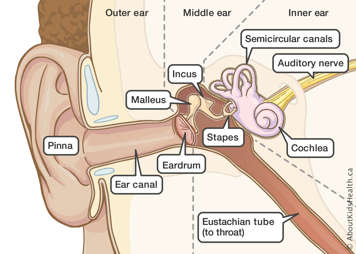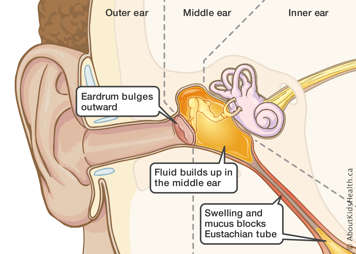What is otitis media?
Otitis media is another name for an infection of the middle ear. The middle ear is the space behind the eardrum. It can become infected by bacteria or viruses.

Symptoms of otitis media
If a child develops otitis media, it usually happens after they have first had an upper respiratory tract infection such as a cold. In children, the signs and symptoms of otitis media include:
In some children, the eardrum develops a small perforation (hole) because of the pressure in the ear. The ear then drains a cloudy or yellow fluid. The hole usually heals within a week or so. Repeated ear infections and perforations can sometimes lead to scarring of the eardrum and longer-term hearing problems.
Causes of otitis media
The Eustachian tube connects the ear to the back of the throat and helps ventilate (air) and drain the middle ear. Otitis media occurs when mucus or swollen tissues from upper respiratory infections block the Eustachian tube. The blockage has two main results.
- It prevents the tube from ventilating the middle ear. This leads to changes in air pressure and possible pain, much like what occurs in an airplane during take-off or landing.
- It causes fluid to build up in the ear and trap any viruses or bacteria that are already there. The fluid build-up can become infected and put pressure on the eardrum, which makes it bulge. This can be painful.

Who is most at risk for otitis media?
Otitis media is most common in children between the ages of six months and two years, but it can occur throughout childhood. Most children will have at least one ear infection. Some children will have many of them.
Children are at higher risk for middle ear infections because their Eustachian tubes are shorter and more likely to be blocked by enlarged adenoids. However, as a child gets older, their ear structures change, and they grow out of the tendency to have ear infections.
How your child's doctor diagnoses otitis media
Your child's doctor will need to examine your child to properly diagnose otitis media. They will look for any fluid in your child's ear and any change in the eardrum. The physical exam will also include a check of your child's neck and throat to see if there are any swollen lymph nodes.
How to prevent otitis media
- Viral upper respiratory infections, including colds, can lead to otitis media. If possible, reducing your child's exposure to those with symptoms of a virus may help reduce the number of viral infections that they experience.
- Wash hands and your child's toys often.
- Ensure that your child is up to date with their vaccinations. Schedule your child's vaccinations (shots) when they are due. Vaccinations such as the flu shot for influenza and the pneumococcal vaccine that is part of the routine vaccination schedule offer protection against acute otitis media.
- Protect your child from second-hand tobacco smoke. Exposure to tobacco smoke can increase the number of infections.
- If you can, offer your child only breast milk for at least the first three months. The antibodies in breast milk may reduce the rate of ear infections and reduce the risk of acute otitis media for your baby during the first six to 12 months of life.
- If you bottle-feed, avoid propping the bottle. This causes the baby to suck excessively and generate extra pressure within the Eustachian tube.
- If your child has had otitis media, try phasing out the use of a pacifier (soother). Using a pacifier may increase the risk of repeated ear infections.
- Consider seeing your doctor if your toddler snores or breathes through their mouth. This can be a sign of large adenoids, which increase the risk of ear infections. Your health-care provider can refer your child to a specialist to check their adenoids if necessary.
How to care for your child with otitis media
Pain and fever relief
Give your child acetaminophen or ibuprofen to help with any earache. These medicines usually begin to work within an hour. If your child needs an antibiotic (see below), continue giving pain relief until the antibiotic takes effect. The pain medicine will not affect the antibiotic.
Antibiotics
Because many ear infections are caused by viruses and not bacteria, the ear infections will resolve on their own. In fact, even some ear infections caused by bacteria will resolve without antibiotics. If the otitis media seems mild and your child is older than six months, your health-care provider may suggest avoiding antibiotics for one or two days to see if the infection goes away on its own.
Your child's health-care provider is more likely to prescribe antibiotics if:
- the otitis media looks worse
- your child has a lot of pain or a high fever
- your child's eardrum has perforated (burst)
Your child's health-care provider may also prescribe antibiotic ear drops if your child's eardrum has burst and is draining fluid.
Antibiotics will kill the bacteria that have caused the ear infection. Although your child should feel better in a few days, you must continue to give the antibiotic until it is finished. This will keep the ear infection from returning and reduce the chance of your child getting an infection that is harder to treat with antibiotics in the future.
Whether your child is prescribed antibiotics or not, it is important to treat any pain or fever that they experience.
Day care and school
Your child can go back to day care or school when the fever is gone and they feel better. Otitis media does not pass from one person to another.
Other everyday activities
Your child can go outside and does not need to have their ears covered. If the eardrum has perforated (burst), your child should avoid swimming until it has healed.
Flying
Flying in an airplane with an ear infection can make an earache worse and increase the chance that the eardrum will burst. However, it does not carry any other risks. Even still, you may decide to avoid flying until symptoms pass.
If flying is unavoidable, bring pain medicine with you on the plane. During take-off and landing, have your child suck on a pacifier (soother) or drink fluids. Swallowing often will help your child balance the pressure in their ears.
Follow-up appointment
Once your child finishes the antibiotic, you may want to make another appointment with their health-care provider. The health-care provider will make sure that your child no longer has symptoms and will check if any damage to the eardrum has healed.
If there is fluid behind the eardrum, it can last for weeks or months. The fluid will normally clear on its own, but your child's health-care provider may wish to monitor your child so they can check for any hearing loss. They may refer your child for a hearing test if needed.
When to see a health-care provider about otitis media
Call your child's health-care provider if:
- your child's fever or pain is not better after taking an antibiotic for 48 hours
- fluid is always draining from their ear
- you are concerned about your child's hearing
Take your child to the nearest Emergency Department if:
- your child's neck gets painful or stiff
- your child seems lethargic (sleepy) or very irritable (cranky)
- your child is vomiting (throwing up) repeatedly and cannot keep down their medicines or enough fluids
- your child has redness and swelling behind their ear
- your child's ear seems to stick out
- your child develops a rash, a puffy face or puffy lips while taking the antibiotic
Your child may show physical changes when their condition is serious or when their condition gets worse. Parents and caregivers can learn how to spot these signs in order to seek help from a health-care provider.
Resources
ECHO Research resources for parents — Ear infection